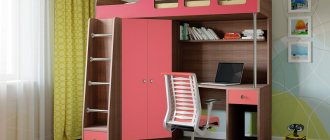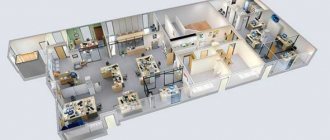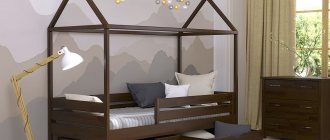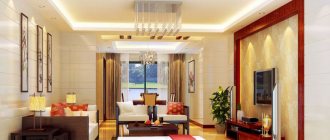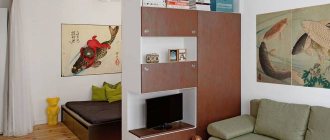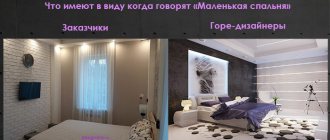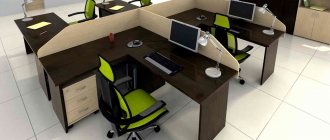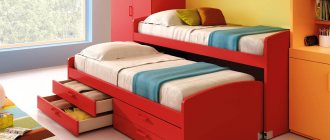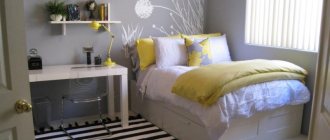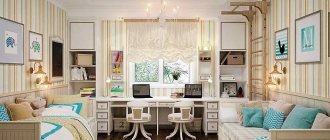Arranging a children's room is a responsible task that requires certain knowledge. In creating a cozy atmosphere, the correct arrangement of furniture plays an important role, the choice of which should depend not only on the preferences of the parents, but also on the wishes of the child. It is important to take into account the gender, age, and temperament of the future owner. There are a number of ergonomic rules and safety requirements that will help you understand how best to arrange furniture in the nursery.
Arranging furniture in a room is much easier if the nursery is intended for one child.
General recommendations for arranging furniture in a nursery
A children's room is a space where a little person will spend most of his free time: play, relax, develop, dream, do homework. Therefore, when planning the purchase of furniture, you need to think about its functional features, performance characteristics and rational placement. Properly selected sets will ensure freedom of movement without compromising cognitive and play activities.
A children's room should be safe, functional, and aesthetically pleasing.
The room should be spacious, functional and compact at the same time. Furniture elements should be selected taking into account simplicity, convenience and safety of use. We must not forget that children grow quickly, so this factor is also important to consider when choosing a headset.
When arranging any nursery, take into account the height of the ceilings, their size, and the condition of the floor and walls.
We remember that a children's room is an activity zone, so there is no point in cluttering the space with massive wardrobes and wide beds with carved decor. You can often find both tiny rooms, tastefully furnished, and “royal” interiors with ridiculous furnishings. Aesthetic perception plays a key role. The belief – “the more expensive and good quality, the better” – is inappropriate here.
The parents' task is to use a minimum of elements to create maximum comfort for their stay.
A number of practical tips will help you get an answer to the question of how to arrange furniture in a children’s room:
We focus on the child's age
The bedroom for a newborn, a preschooler and a student are very different from each other. In a room for children, it is advisable to use a minimum of furniture and interior items. An abundance of chests of drawers and cabinets designed for the needs of newborns will continue to stand idle, taking up useful space. You should fill the room with furniture gradually, just as you will have to make adjustments to the arrangement system as your beloved child grows up.
The games sector will be the largest for preschoolers from 3 to 6 years old, but the educational sector will be absent for obvious reasons.
It is better to seriously think about a set closer to 3-4 years old, when it is time for a child to buy his first individual furniture set. Please note that it is better to place furniture along the walls, thereby leaving the middle of the room free. The filling can be very different: a corner wardrobe or compartment, a traditional desk or a “growing” desk, bedside tables, poufs, a couch, an elephant sofa or a car bed, a bunk bed or an attic.
When your child starts going to school, you will have to think about purchasing a computer desk, which will inevitably reduce the size of the gaming sector.
Practicality and safety are the basis of choice
Furniture must be arranged in such a way as to eliminate the risk of injury. Preference should be given to durable structures. Children learn the world by touch; younger schoolchildren tend to be constantly on the move, so you should make sure that upholstered and cabinet furniture has no sharp corners.
The bed should not be positioned with the head of the bed facing the radiator or window - this will protect the child from respiratory diseases.
Ergonomic rule
There should be as much free space as possible in the nursery. Zoning is a prerequisite for teaching a child order and discipline. Usually there are sleeping, sports and play areas and work areas. It is important to equip each one in accordance with its purpose.
Poufs and chairs in the play area should not have sharp corners - this reduces the risk of injury during active games.
How to choose the right colors
Color psychology: effects of perceiving color on psychological functioning in humans. on the emotional state of the child. Some shades evoke melancholy and depression, while others evoke joy and inspiration. Therefore, it is important to choose the right color scheme for the nursery. The main rule is not to oversaturate the room with one color and not to make it too bright. It is better if the room is in calm pastel colors with bright accents on the walls or decorative items.
When choosing color accents, focus on the psycho-emotional characteristics of the child (active and easily excitable, calm and shy). It is important to choose colors so that they do not interfere with schoolwork, games and sleep.
Here's how some colors affect the emotional state of children:
- Perception of the color red enhances the force and velocity of motor output. heart rate and breathing rate, as well as physical activity. Too much red can cause aggression and anxiety. However, small red accents can improve concentration and help a shy child feel more confident.
- Children's Emotional Associations with Colors. with sunlight and evokes joyful emotions. If there is a lot of yellow, it is difficult for the child to calm down and fall asleep.
- Blue color calms Color-emotion associations: Past experience and personal preference.. It is well suited for easily excitable children and reduces physical activity. But if you overdo it, it will have an overwhelming and depressing effect.
- The color brown hasChildren's Emotional Associations with Color. has a calming effect because it is associated with nature. Children who are anxious will feel good in a room decorated in these colors. However, brown must be combined with beige and other pastel shades, otherwise it will constrain and suppress the child.
- Green is considered a good choice for a child's room because it is the color of nature and freshness (especially if you use soft green shades). It enhances Fertile green: green facilitates creative performance. reading ability and imagination, enhances creativity.
- The color pink evokes Children's Emotional Associations with Color. delight and other positive emotions. In addition, it develops empathy and a sense of caring, so a room with pastel pink shades is an option that has nothing wrong with it.
Ask your child's opinion, but offer options to choose from. For example, ask, “Do you prefer this blue or this green?”
Arrangement in a rectangular children's room
Owners of an oblong shaped room are less fortunate than owners of square rooms. This is due to the fact that, although they have the same quadrature, they have different lengths. And this restricts the boundaries of the interior. Most people are accustomed to installing furniture around the perimeter, adhering to the principle of symmetry. This belief is completely wrong. Asymmetrical placement looks more advantageous, turning the disadvantages of a rectangle into advantages.
Cabinets for storing things and toys can be located next to the play area.
In the question of how to correctly arrange furniture in a nursery, the rules for zoning rooms will help you understand:
- The sleeping and resting area should be located so that the child can see the entrance to the room. It is advisable to place the bed along a long wall. Install a closet opposite. Place a chest of drawers for linen there. If space allows, put a bedside table to store handy things: books, alarm clock, mobile phone, glasses case, etc. This solution will smooth out the shortcomings of an elongated shape. The ideal option is a loft bed.
Bunk beds are ideal for cramped rooms.
- The work area is located in the brightest place - near the window opening. Please note that if the window is located on a long wall, then it is preferable to place a corner for study and creativity to the right or left of the window sill. If it’s short, it’s right under it.
Additionally, you can purchase a shelf for books and stationery.
- Any free space can be allocated to the playing area. If the square footage allows, we separate the place with a podium. There is minimal furniture here. The maximum that is allowed is a narrow shelf or chest of drawers for toys and other accessories.
To store things that need quick access, install hanging shelves on the wall so that the student can reach them independently.
A successful arrangement of the elements of the set will help to avoid typical mistakes in the interior design of the room. The basic rule - turning a rectangular bedroom into a square one - will not allow you to disrupt the proportions of the room or create a “carriage” effect. We place the small opposite the massive, the tall - opposite the low.
There should be no sockets, wires or other dangerous objects in the recreation area.
Work zone
A desk should ideally be placed near a window to catch maximum daylight. As a last resort - along the side wall closer to the window, so that the light falls from the left for a right-handed child. It is more convenient to make drawers for school supplies directly in the table or above it, so that you do not have to stand behind each notebook. The table must be additionally illuminated in the evening with a table lamp or sconce.
Options for arranging two beds in a nursery
Not every family has the opportunity to allocate two separate rooms to each child. This situation is common. Parents are faced with a dilemma about how to install two beds in the nursery so that the room is suitable not only for sleeping, but also for free time. It turns out that it is possible to do this.
The flooring should be soft and warm - children love to lie, crawl, tumble and can catch a cold or get bruised.
It is possible to save precious meters and leave space for active activities and study if you use the following bed options:
- Two-tier or three-tier – the most ergonomic way of placement.
If the children's room is small, you can combine the storage area with the sleeping area.
- Roll-out ones are an ideal option for those who are afraid of heights.
Manufacturers produce a huge number of interesting options for beds with secret drawers and shelves.
- Hanging ones are not the most popular models due to their high cost. But pricing is justified by the complexity of manufacturing and increased requirements for design reliability.
The arrangement of furniture and main areas depends on the geometric dimensions of the nursery.
IMPORTANT! In children's rooms, it is permissible to use only models with additional removable and non-removable sides. Fastenings will protect against involuntary falling from place.
Opponents of multi-level structures prefer free-standing beds. In families where two or more children are growing up, they can be arranged in different ways:
- The linear method is a good solution for elongated rooms. They can be placed close together or separated by a partition, cabinet, cabinet, or carpet.
If the room is spacious and has a rectangular or square shape, you can divide it with a cabinet or partition.
- A parallel arrangement based on the “kindergarten” principle is ideal for square rooms. It is appropriate to use while the children are small, then you will have to make a rearrangement: place the beds opposite each other.
A more difficult task is to arrange a nursery for children with a large age difference.
- Corner placement is a way of zoning space in a small room. Bedroom furniture is arranged in the shape of the letter “L”. You can place them either in opposite corners or “head to head”. On the contrary, you can easily organize, for example, an entertainment area.
If children are of different sexes, it is necessary to visually separate the sleeping places with a partition, screen, curtain or finishing materials.
Lighting
It is important to make the light in several levels in order to illuminate each zone separately and create peace before a night's rest. In addition to the lamp on the ceiling, you will need table lamps and wall sconces. Spot lighting devices can be built into ceiling structures. Colored lighting is suitable for highlighting areas.
Photos from 2022 demonstrate the ideal interior and furniture designs for children's rooms for schoolchildren. The space can be decorated in different ways. The main thing is that the environment motivates personal development. It is necessary to create an atmosphere for this.
Did you like the article?
Recommendations for arrangement in a narrow room
The most difficult task is to create a comfortable living environment in a cramped space. Organizing a competent sector for recreation, leisure and storage of things is very difficult. A number of effective tips will help you deal with the problem of limited space:
- Use every corner rationally and to the maximum.
- Combine several zones into a single whole, choose a bunk bed or a loft bed. Such models include two or more elements at the same time: a sleeping place, a storage system, a desk, etc.
For small rooms, the optimal solution is to purchase a loft bed with a bed on the second tier and a work area on the first.
- Choose furniture with U- or L-shaped modules.
- Preference should be given to multifunctional models: replace standard beds and tables with folding ones and transformers.
- The use of multi-level and high headsets will significantly save space.
If you decide to put a closet in the nursery, it should have many shelves located at a convenient height so that the child can take things on his own.
It is important not to upset the balance. It would look better to have one closet up to the ceiling with sliding doors than several small ones with hinged doors. This design will visually expand the space. Above the entrance you can create a corner of closed wall shelves for storing out-of-season items.
The ideal layout is the location of working and sleeping places away from each other.
Photos of interesting examples of furniture arrangement in the interior of a nursery
The Internet presents several ready-made interesting solutions for arranging furniture sets in a nursery.
When arranging furniture in a children's room, primary importance is given to functionality and reliability, and only then to the aesthetic component.
It is important to consider that a child is a perpetual motion machine, a small motor who finds it difficult to sit still. Therefore, you need to organize the space so that it is pleasant not only to sleep, but also to have fun with friends.
Remember about safety: before purchasing, be sure to check the certificate for the frame, upholstery and filling.
Basic rules for comfortable zoning
A children's project is not just a design, but the correct arrangement of furniture, taking into account the available space.
Design and layout of a children's room measuring 15 square meters. m.
Unique interior design is a manifestation of taste and individual preferences; it directly depends on the stated requirements. But the layout of a small nursery is all about taking into account all the general requirements to create the most comfortable conditions.
A little advice: before starting decorative finishing of the floor, it is important to carefully consider the overall interior of the room so that all these actions do not lead to a violation of the compatibility of tones in the color scheme.
The design of a small nursery for a girl should, like a large one, consist of a small working, sleeping and play area. Compliance with this condition is required for the comfortable development of the child, and one should not lose sight of education and good leisure time. The main thing is that study and well-deserved rest after school do not overlap with each other and are clearly demarcated.
